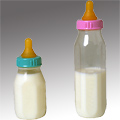
Cantaloupe contamination attributed to packing facility-not fields
Some consumer watchdog groups and blogs were quick to point out close-by CAFOs (concentrated animal feeding operations) were responsible for the Listeria contamination either through runoff or other means of transport (e.g., using waste as fertilizer). The animal population, according to Food and Water Watch’s 2007 numbers, in
Listeria monocytogenes are not the first bacteria that come to mind if a contamination is due to animal causes, said Dana Johnson in an FE interview. Johnson is brewery and produce specialist at Birko Corp., a
While FDA did not rule out that Listeria may have originated from the fields, its mode of entry to the packing plant was not on the cantaloupes, according to Johnson. Johnson recommends foaming entryways to any packing facility or food plant because very low residual levels of Listeria can be found most anywhere in the world on the ground, and they can enter a facility on workers’ shoes. Johnson’s company has many years of experience in the protein industry, and he thinks a multiple hurdle approach to pathogen reduction should be followed in the produce industry just as it is in the meat industry.
Once Listeria monocytogenes bacteria enter a cool, damp environment, they thrive and don’t have a lot of competition from other bacteria that prefer warmer temperatures to multiply, says Johnson. Another potential mode of entry, according to FDA, was a truck used to transport culled cantaloupes to livestock farms where the melons were used for feed.
In an exclusive FE interview, Mary Root,
On September 10, 2011, FDA and
Certain aspects of the packing facility, including the location of a refrigeration unit drain line, allowed water to pool on the floor in areas adjacent to packing facility equipment, according to FDA. Wet environments are known to be potential reservoirs for Listeria, and the pooling of water in close proximity to packing equipment, including conveyors, may have extended and spread the pathogen to food contact surfaces.
Of the 39 environmental samples collected from within the facility, 13 tested positive for Listeria with pulsed-field gel electrophoresis (PFGE) pattern combinations that were indistinguishable from three of the four outbreak strains collected from affected patients, according to FDA. Cantaloupes collected from the producer’s cold storage during the inspection were also confirmed positive for Listeria with PFGE pattern combinations indistinguishable from two of the four outbreak strains.
As a result of the isolation of three of the four outbreak strains of Listeria monocytogenes in the environment of the packing facility and whole cantaloupes collected from cold storage, and the fact this is the first documented Listeriosis outbreak associated with fresh, whole cantaloupes in the US, FDA is making several recommendations for good practices. Producers should:
- Assess produce facility and equipment design to ensure adequately cleanable surfaces and eliminate opportunities for the introduction, growth and spread of Listeria monocytogenes and other pathogens.
- Assess and minimize opportunities for introduction of Listeria monocytogenes and other pathogens in packing facilities.
- Implement cleaning and sanitizing procedures.
- Verify the efficacy of cleaning and sanitizing procedures.
- Periodically evaluate the processes and equipment used in packing facilities to assure they do not contribute to fresh produce contamination.

Green sustainable technology at PROCESS EXPO 2011
Darryl Wernimont of POWER Engineers will lead this seminar. Wernimont has been active in green technology for the past 11 years, having served on the LEED (Leadership in Energy and Environmental Design) Council for nine of those 11 years.
“I can remember in 2000 talking with some clients who for the first time began to discuss green sustainable initiatives leading toward LEED certification of buildings,” says Wernimont. “Today every client is discussing it at some level.” Looking forward, Wernimont predicts “the next wave or generation of sustainability will involve a more focused challenge of existing facilities and operations.”
The seminar will include a discussion of energy audits and the identification and understanding of what is actually occurring in plant operations. This knowledge will allow a facility to take actions to achieve measurable sustainability. The actions taken will drive the implementation of PLCs, PCs, software, instrumentation and alternative energy to achieve sustainable objectives.
Attendance at this, and all educational sessions at PROCESS EXPO, is free of charge for all registered attendees. To register, or obtain more information about the program, visit the PROCESS EXPO website.
Trade agreements expand US surplus
“We applaud President Obama for signing into law free trade agreements [FTAs] with
“The FTAs will be critically important to increasing the exports of US food and consumer products to these growing markets. By creating a level playing field, the FTAs with South Korea, Panama and Colombia will increase our competitiveness in these countries and help the food, beverage and CPG industry innovate, expand and create new jobs,” says Bailey.
“Our competitors have negotiated their own trade agreements with
Chocolate dress makes debut
Artist Willy G. designed a one-of-a-kind, bustier dress for Cacao Barry, the premium chocolate brand from Barry Callebaut. Maîtres chocolatiers Philippe Bertrand, Meilleur Ouvrier de France Chocolatier (1996) and director of the Chocolate Academy Cacao Barry in Meulan (France), and Ramon Morato, Meilleur Maître Chocolatier Spain (1997) and director of the Chocolate Academy in Vic (Spain), required a total of 30 hours to create the unique dress.
Zurich-based Barry Callebaut had annual sales of $4.9 billion for the fiscal year 2009/10 and manufactures high-quality cocoa and chocolate-from the cocoa bean to the finished chocolate product.Automation News

Grocery wholesaler found rugged computer easy to use
The mobile computer met all of Krasdale Foods’ hardware selection criteria, including industrial-grade construction, fast processing speed and strong WLAN performance. The XG100’s battery location was also an important consideration. “We do more than just provide groceries to our customers. We also offer state-of-the-art technology and services to assist our clients in this competitive market. We are excited about selecting Janam as our partner in this endeavor,” says Steve Laskowitz, CIO at Krasdale Foods. “User acceptance was an important qualifier. The battery in the handle makes the XG100 feel extra light and balanced in hand, so we were confident we would be offering our customers a product that is comfortable and easy to use.”
Janam’s XG Series was designed for scan-intensive, extended shift use in demanding environments. Built for the work at hand, the XG Series line of products offers industrial-quality construction and efficiency-enhancing features such as pre-installed Wavelink Avalanche and TE, well-spaced keys and mobile DDR memory.
For more information: Bernadette Olsen, Janam Technologies LLC, 516-677-9500 Ext. 104, bernadette.olsen@janam.com; website.
Pork pie producer picks toughened thermometer
Food safety management for any producer is of the utmost importance, and Pork Farms is making use of state-of-the-art temperature probes, which have been developed specifically for a food production environment.
“Temperature monitoring is critical for our business as it has to be exactly right at all stages of production to avoid any problems with the product,” says Ellen Winters, Pork Farms assistant technical manager. “The system we used before was prone to faults as the thermometers regularly cracked and needed to be replaced. We have been [testing] the new Digitron 8146 temperature probe, and it has proved to be far more effective and hard-wearing.”
Winters has seen the benefits of the system, which has helped her team monitor conditions at the company’s storage facilities in the
“We check our temperature readings every day, and all of our storage units now use the system. The unit’s removable protective covering, the boot, is particularly useful and can be easily cleaned when necessary,” says Winters.
With a practical ergonomic design, the 8146 temperature probe comes complete with SteriTouch antimicrobial casing. It is lightweight and easy to use, making it ideal for use in kitchens, labs and food manufacturing plants. The thermometer has ultrasonically welded seams and is waterproof to an IP67 protection rating with a Lumberg connector, making it easy to clean with flush surfaces to minimize food traps.
For more information: http://www.digitron.co.uk or contact US Sales, 760-799-5668, gcasillas@digitron.com.
Cooling tower enjoys second life at Hawaiian rum processor
To begin, the father and son team, Paul and Brian Case, had to make a substantial investment that would meet the federal code governing building facilities. These were stringent, applying to stainless steel tanks, boilers and other distillation equipment. Also, the regulations require an elaborate fire containment system, one that could make 3,500 gallons of water per minute available with a flow that could be sustained for three hours. And, finally, they needed a reliable cooling tower that could remove the heat from the alcohol condenser system regardless of weather conditions.
Paul Case explains that the cooling tower was integral to the operation of the distillery’s alcohol condensation process. “After vaporous alcohol leaves our stills, it runs through a condenser, which condenses the alcohol back to a liquid form so we can process it. The condensers are cooled by water. So, we have to take that water, which becomes heated while cooling the alcohol, and send it to the cooling tower to reduce the water temperature, and then back through the continuous condenser loop.”
Selecting an appropriate cooling tower was a special consideration due to
In the process of exploring alternatives, Case found a used cooling tower constructed of heavy-duty, engineered HDPE that was available from a computer chip manufacturer that had closed a plant in
“I did some research and found that the cooling tower manufacturer produced a quality product, and decided that for the price, we could afford to buy the secondhand tower and controls, have it disassembled, shipped to Maui and reassembled at our distillery site,” says Case.
The Paragon model is relatively light in weight, impervious to UV rays and corrosion-proof. Case says he was very impressed with the weather tolerance of the cooling tower, which had operated for about six years in the brutal winters of the northeastern US and now has operated in the tropical sun at the distillery since 2006.
After the cooling tower operated flawlessly for years in
Case’s maintenance people were able to quickly replace the entire fan assembly, which was a proprietary, non-corroding, fiber-reinforced, polypropylene unit. Immediately afterward, the plant was back up and running again.
“When you consider that the cooling tower had changed hands about five years ago and was about 15 years old, Delta Cooling really took fabulous care of us,” says Case.
Case adds the design of the cooling tower fan system provides important energy savings, because the tower controls regulate the speed of the fan according to the ambient air temperature.
“In the cooler morning hours, the fan doesn’t even come on,” says Case. “Then, later in the day as the ambient air warms up, the fan rotates automatically at the appropriate speed to cool the condenser water from up to about 180º back to about 80º.”
Today, Kolani Distillers’ Old Lahaina Premium Rum is sold throughout the
Food Safety News

Reusable shopping bags: proceed with caution
The study tested 87 reusable bags obtained at random from grocery shoppers in
“I was surprised to learn through this study that only 3 percent of shoppers surveyed actually said they washed their reusable bags between uses,” says Gerba. “More surprising were the numbers of people who stated they used the bags not only for food shopping, but also to transport clothing and other products to and from work and the gym.
“There has been a growing movement to use reusable bags when we shop, but without proper washing, these bags can expose our families to bacteria that can cause illness,” adds Gerba.
Reusable bags are particularly susceptible to contamination since remnants of meats and dairy products which may seep out of packaging remain in bags unless washed out, resulting in bacterial growth. Once subjected to the heat of a car trunk, these bacteria quickly multiply.
“Washing bags is the only way to protect your family. It will remove 99.9 percent of germs. Although it may be a nuisance, washing must be done to ensure your food is safe to eat,” adds Gerba. “I’d recommend washing it with hot, soapy water after each use.
“If you choose to use a reusable bag for grocery shopping, it’s important to keep your meats in separate plastic bags, use separate reusable bags for food items, and wash them between uses,” concludes Gerba.
An abstract of the study, Assessment of the Potential for Cross-contamination of Food Products by Reusable Shopping Bags, can be found on the International Association for Food Production website.
FDA should assure consumers BPA is no longer used in baby bottles
“Although governments around the world continue to support the safety of BPA in food contact materials, confusion about these products has become an unnecessary distraction to consumers, legislators and state regulators,” says Steven G. Hentges, PhD, of the Polycarbonate/BPA Global Group of ACC. “FDA action on this request will provide certainty that BPA is not used to make the baby bottles and sippy cups on store shelves, either today or in the future.”
Recent state actions (see Tech Flash 5-11 [June 10, 2009]) have contributed to confusion about whether baby bottles and sippy cups sold in the

Practical test for E. coli serogroups
The suite of food safety tests, the BAX System STEC Suite, was developed in collaboration with the Agricultural Research Service of the US Department of Agriculture (USDA ARS) and is closely aligned with the testing approach used by the Food Safety and Inspection Service (USDA FSIS).
The screening assay detects a combination of virulence genes-called stx and eae-to quickly clear negative samples in the production line. Two multiplex panel assays can determine which of the top six non-O157 STEC serogroups-O26, O45, O103, O111, O121, O145-are present in positive samples. The USDA recently declared these pathogenic serogroups as adulterants in non-intact beef, and FSIS will begin enforcing a zero tolerance policy in March 2012.
The automated system uses PCR assays, tableted reagents and optimized media to detect Salmonella, Listeria, E. coli, Campylobacter, Vibrio and more. The system has certifications and regulatory approvals in the